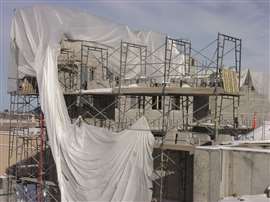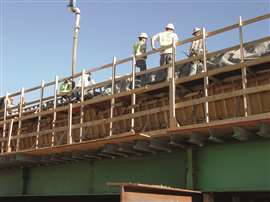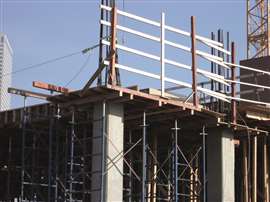Working at height: When can I fall?
07 May 2024
In an apparent effort to reduce or eliminate falls from heights, government agencies, industry institutes, associations, unions, employers, and others seemingly too numerous to list, have promulgated rules, regulations, guidelines, standards, requirements, codes, checklists, admonitions, fines and threats. Unfortunately, it doesn’t seem to be working too well. Falls from heights consistently are a primary cause of injuries in the construction industry.
 Some regulations do not explicitly allow the use of a personal fall arrest system on scaffolds, only a guardrail system. (Photo: David Glabe)
Some regulations do not explicitly allow the use of a personal fall arrest system on scaffolds, only a guardrail system. (Photo: David Glabe)
The typical response to this fact is more rules and regulations in the belief that the problem will go away if we have more rules and regulations. An analysis of the written material on the subject suggests that perhaps too much of the material is ineffective. One would think that in these United States – get it, united, there would be one source for regulations addressing fall protection. After all, if you fall in Maine, it will be pretty much the same as if you fall in Hawaii.
Protecting workers
But such is not the case, apparently, since there are multiple federal and state agencies that have their own regulations addressing fall protection. Fortunately, most states have determined that workers should be protected from falling from scaffolds once they reach 10 feet above the level below.
Not surprisingly, however, California is different and requires protection at 7-1/2 feet.
But wait, there’s more. If you happen to be working on a ship where the OSHA Maritime Industry regulations apply, you have to be protected once you are 5 feet above the level below, whether on a scaffold or other work surface. Perhaps Maritime workers don’t know how to fall.
Not to be outdone, the Army Corps of Engineers has its own requirements for fall protection. The Army Corps requires fall protection once the worker is 6 feet above the level below; it makes no distinction between working surfaces and scaffold platforms.
Not to be outdone by the federal government agencies, various states have managed to modify federal regulations to their own liking by massaging the federal regulations or writing their own regulations. Washington state and Michigan are two examples.
Not to be left out of the regulation writing contest, New York has decided that scaffolds require a guardrail system when the worker is more than 7 feet above the level below. But wait, we’re still not done with regulations. There are cities that have regulations governing fall protection and scaffolding. For example, New York City requires scaffold permits and inspections. It is presumed that inspections would include fall protection.
Different industries, different problems
Let’s see what we have so far. Depending where you are and whether you are on a working surface or a scaffold dictates when fall protection is required, ranging from 5 feet in the Maritime Industry to 10 feet in the General and Construction Industries. It seems the laws of physics apparently can be modified. Or perhaps not.
 Most states have determined that workers should be protected from falling from scaffolds once they reach 10 feet above the level below. (Photo: David Glabe)
Most states have determined that workers should be protected from falling from scaffolds once they reach 10 feet above the level below. (Photo: David Glabe)
As with life, there are exceptions. Scaffold erector fall protection is determined by the employer. And then there are steel erectors and roofers. Certain steel erectors can be exposed to fall heights up to 30 feet although they have to wear fall protection equipment at 15 feet but don’t have to hook up. Go figure. Roofers can be exposed to falls as long as they have a monitor ready to tell them when they are about to fall.
At least one can have fun with the regulations. The Army Corps specifies that the guardrail be lumber, a flat bar, or a pipe. What would happen if you used a steel angle, which is a common guardrail on frame scaffolds, or a tube in place of a pipe, common on many scaffolds?
What rail?
We aren’t done.
The construction of a guardrail system, that is the assembly of the toprail, the midrail, and guardrail posts are addressed in a variety of ways in the various regulations. Federal OSHA specifies that the toprail on scaffolds be between 38 and 45 inches. On other working surfaces, the range is 39-45 inches. Can it be assumed that workers are scaffolds are shorter? The Corps of Engineers specifies 42 inches, plus or minus 3 inches.
That appears to be the same as 39 to 45 inches, but you never know. California agrees with the Maritime folks and requires the toprail be installed 42 to 45 inches above the platform. Apparently seafarers and Californians are taller. And then there is the midrail.
General Industry, Construction Industry, and California regulations agree, there’s a surprise, that the midrail be installed approximately halfway between the toprail and the platform. Not so the Corps or Maritime where the midrail must be installed halfway; none of this approximate stuff. Interestingly, some regulations do not explicitly allow the use of a personal fall arrest system on scaffolds, only a guardrail system. At least, that is how some regulations are written.
 Federal OSHA specifies that the toprail on scaffolds be between 38 and 45 inches. (Photo: David Glabe)
Federal OSHA specifies that the toprail on scaffolds be between 38 and 45 inches. (Photo: David Glabe)
The writing’s on the wall
It’s clear from a review of the voluminous regulations that science and physics have no influence on the numbers used. Admittedly, it can be reasonably concluded that the regulation writers recognize that falling from heights can be detrimental to one’s physical health.
Despite the indisputable fact that the further you fall and the quicker you come to a stop dramatically affects the force that your body receives, it appears that no one can agree on what the freefall distance should be.
This brings us to an issue that frequently occurs on jobsites and that is how precise a guardrail system must be when it is installed. If a toprail is one inch too high or too low, does that a violation make? Does that a hazard create? I doubt it, but then I don’t enforce regulations.
There appears to be one thing that the regulations agree on and that is the strength of the toprail and midrail. If you don’t know what that is, look it up because if I give it to you, I may be wrong since I doubt I have found all the applicable regulations in existence.
One last thing; the regulations do not agree on how that load is applied. Some regulations say any outward and downward force, some say any horizontal and downward force. At least they don’t say upward force, but then the regulations can always be revised.
David Glabe is president of Glabe Consulting Services Inc., a company he founded in 1985. The company provides litigation services in the areas of temporary structures, construction, fall protection, shoring, forming and OSHA safety. Glabe is also the founder of DH Glabe & Associates, [www.dhglabe.com] a firm that specializes in construction engineering, including fall protection systems, scaffolding, shoring, wall forming and temporary structures.
CONNECT WITH THE TEAM




